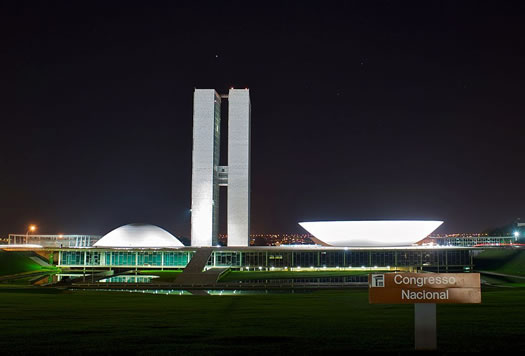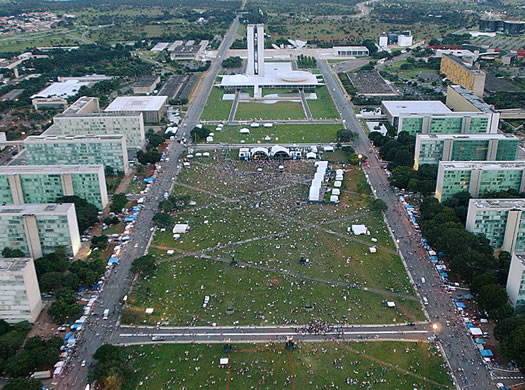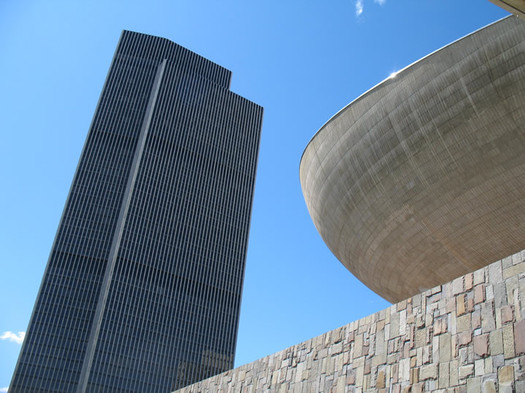Albany's reflection of Brazil

The National Congress Building in Brasilia. Look familiar?
Without all the attention focused on Brazil right now for the World Cup, we thought it'd be interesting to highlight a reflection of the country in Albany.
Yep, Albany.
The capital of Brazil had been Rio de Janeiro staring in 1763, but a longstanding provision of the country's constitution stated the capital should be moved to a more central location in the large country. And in the 1950s the Brazilian government decided to do that -- specifically to design a whole new capital city from scratch. The story goes that the name -- Brasilia -- came from the Catholic saint Don Bosco who dreamed of a utopian city in the 1880s.
The planner chosen to layout Brasilia: Lucio Costa. And one of his close friends was picked to design many of the buildings: architect Oscar Niemeyer.
In the 1940s Niemeyer made a name for himself as one of the rising figures in the growing modernist architecture movement. And in 1947 he selected to be part of a board of design tasked with designing the headquarters for the United Nations in New York City. The project was completed in 1952.
Niemeyer moved on to work on Brasilia, and construction started on the city in 1956, and the result was a landmark of midcentury modernism -- and not a little sci-fi.

photo: Fabio Rodrigues Pozzebom/ABr (CC BY 3.0 BR)
Writing about the then-100-year-old Niemeyer for the New York Times in 2006, architecture critic Nicolai Ourousoff noted of Brasilia and its "a trove of Modernist landmarks conceived on the grandest scale" (emphasis added):
Such structures are arranged along the plazas with the precision of pieces on a chessboard. The spaces among them convey both an airiness and a subtle tension among their varied forms, charging the whole with energy.
Completed in an era when millions of Americans were fleeing cities for the homogenous suburbs of the Eisenhower era, and Europe was still limping through its recovery from World War II, BrasÃlia seemed to assert that erotic desire and human tenderness had a place in modern society. Better still, the stunning speed of its construction suggested that this sensual utopia was only as far away as the next cocktail.
The force of that vision reverberated across the United States and Europe. Lincoln Center in Manhattan, Empire State Plaza in Albany, the Los Angeles Music Center -- all owe a debt to Niemeyer. And today a young generation versed in computer enhancement has found inspiration in his fluid concrete curves.
Right, so about the connection with Albany. Nelson Rockefeller was fan of modern architecture and art, so the fact the Empire State Plaza, the construction of which started occurred during the 1960s and 70s, would draw inspiration from Brasilia isn't a surprise. That 1963 half-prescient/half-bonkers plan for Albany makes reference to the Brazilian capital.

But let's also back up to that UN commission on which Niemeyer served. The head of that commission: Wallace Harrison, an important figure in modernism in his own right. And, as you might already know, Harrison was the architect of the Empire State Plaza. So there's another connection -- and a strong one.
It's remarkable to us that the most noticeable part of Albany's skyline draws significant influence from a city on the flip side of the equator. And it's the sort of thing that seems very much of its time -- it's hard to imagine a project of that scale, and of that influence, happening here today.
Here's a good photo set of Niemeyer's architecture.
Top Brasilia photo: Flickr user Rob Sinclair (CC BY-SA 2.0)
Hi there. Comments have been closed for this item. Still have something to say? Contact us.
Comments
The other inspiration being that Brazil in the 1970s had an authoritarian government, and only such a government would dispel and destroy such a large portion of a city to build such a useless monument.
Brasilia was actually built on greenfield though. Even the Brazilian government might have had a hard time knocking down half of an existing city to build it.
... said Brandon on Jun 26, 2014 at 2:19 PM | link
My cousin came to visit from Vienna and I took him on the .50 tour of Albany, including the ESP. Having recently traveled to Brasilia he noted the odd similarities. I guess they're both manufactured cities instead of naturally evolving ones!
... said Kate on Jun 26, 2014 at 8:29 PM | link
This will likely provoke some personal swipes -- that fail to address the content of my comment -- from my “fan club,†but it’s worth noting that Nelson Rockefeller’s taste in modern art (and by extension modern “architectureâ€) was financed covertly by the CIA during the Cold War.
“Modern art was CIA 'weapon'â€
The Independent
Friday 27 June 2014
http://www.independent.co.uk/news/world/modern-art-was-cia-weapon-1578808.html
From the article:
“The connection is improbable. This was a period, in the 1950s and 1960s, when the great majority of Americans disliked or even despised modern art - President Truman summed up the popular view when he said: "If that's art, then I'm a Hottentot." As for the artists themselves, many were ex- communists barely acceptable in the America of the McCarthyite era, and certainly not the sort of people normally likely to receive US government backing
…
“And, we now know, it promoted America's anarchic avant-garde movement, Abstract Expressionism.
“Initially, more open attempts were made to support the new American art. In 1947 the State Department organised and paid for a touring international exhibition entitled "Advancing American Art", with the aim of rebutting Soviet suggestions that America was a cultural desert. But the show caused outrage at home, prompting Truman to make his Hottentot remark and one bitter congressman to declare: "I am just a dumb American who pays taxes for this kind of trash." The tour had to be cancelled.
…
“Pre-eminent among these was Nelson Rockefeller, whose mother had co-founded the Museum of Modern Art in New York. As president of what he called "Mummy's museum", Rockefeller was one of the biggest backers of Abstract Expressionism (which he called "free enterprise painting"). His museum was contracted to the Congress for Cultural Freedom to organise and curate most of its important art shows. The museum was also linked to the CIA by several other bridges.â€
Here’s a video highlighting Rocky’s modern art on display throughout the Empire State Plaza and in the Morlock tunnels beneath Albany.
http://www.youtube.com/watch?v=nuZ30-kh8JY
... said Duncan Crary on Jun 27, 2014 at 1:54 AM | link
@Duncan - Let's not overplay your hand, now. Please don't forget the conclusion:
"Would Abstract Expressionism have been the dominant art movement of the post-war years without this [CIA] patronage? The answer is probably yes. Equally, it would be wrong to suggest that when you look at an Abstract Expressionist painting you are being duped by the CIA."
... said Jay on Jun 27, 2014 at 12:55 PM | link